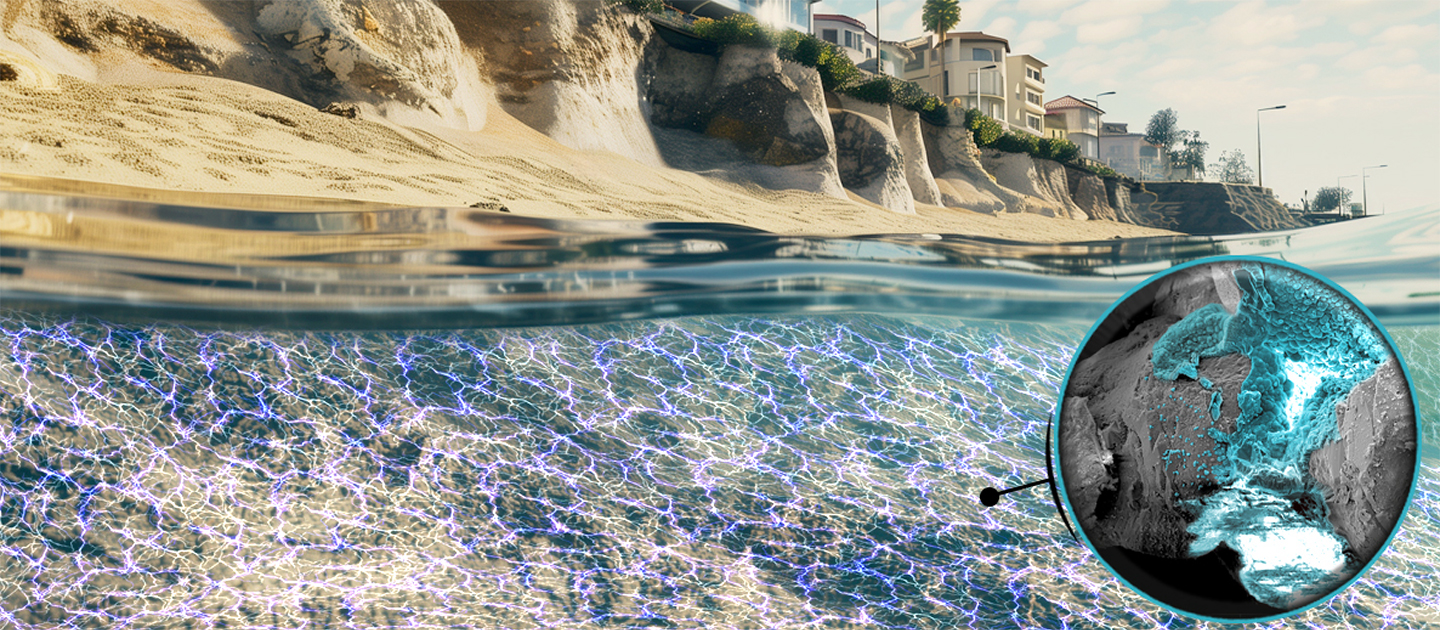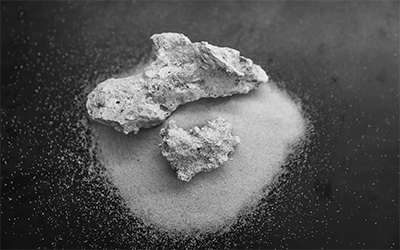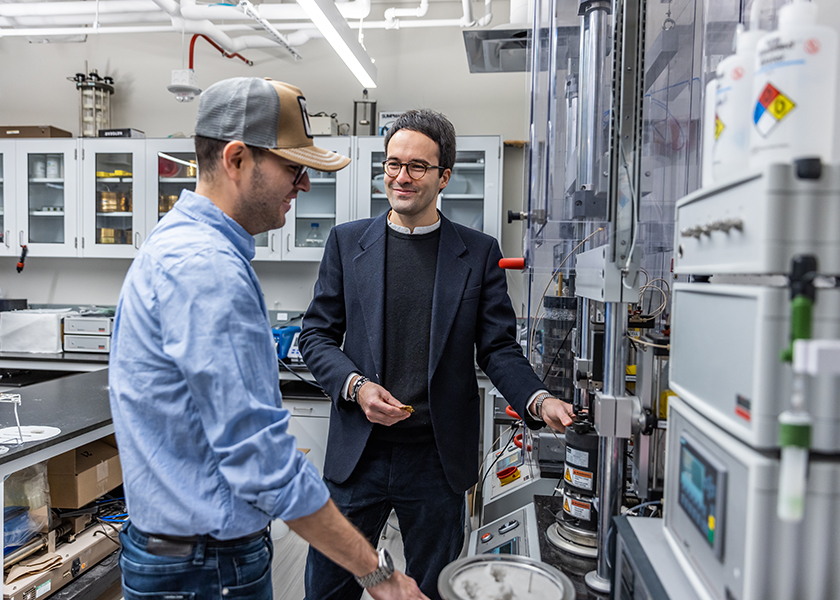The Problem
With climate change and rising sea levels, coastal erosion is an increasing threat.

With climate change and rising sea levels, coastal erosion is an increasing threat.
A new process that uses electricity to form a natural cement between grains of sand, transforming it into solid, immoveable rock.
This strategy could offer a lasting, inexpensive, and sustainable solution for strengthening global coastlines.
Professor Alessandro Rotta Loria; Andony Landivar Macias, former PhD candidate in Rotta Loria’s laboratory; Steven Jacobsen, Weinberg College of Arts and Sciences professor
New research from Northwestern University has systematically proven that a mild zap of electricity can strengthen a marine coastline for generations — greatly reducing the threat of erosion in the face of climate change and rising sea levels.
In the new study, researchers took inspiration from clams, mussels and other shell-dwelling sea life, which use dissolved minerals in seawater to build their shells.
Similarly, the researchers leveraged the same naturally occurring, dissolved minerals to form a natural cement between sea-soaked grains of sand. But, instead of using metabolic energy like mollusks do, the researchers used electrical energy to spur the chemical reaction.
In laboratory experiments, a mild electrical current instantaneously changed the structure of marine sand, transforming it into a rock-like, immoveable solid. The researchers are hopeful this strategy could offer a lasting, inexpensive and sustainable solution for strengthening global coastlines.
The study was published Aug. 22 in the journal Communications Earth and the Environment, a journal published by Nature Portfolio.
“Over 40 percent of the world’s population lives in coastal areas,” said Northwestern Engineering’s Alessandro Rotta Loria, who led the study. “Because of climate change and sea-level rise, erosion is an enormous threat to these communities. Through the disintegration of infrastructure and loss of land, erosion causes billions of dollars in damage per year worldwide. Current approaches to mitigate erosion involve building protection structures or injecting external binders into the subsurface.

“My aim was to develop an approach capable of changing the status quo in coastal protection — one that didn’t require the construction of protection structures and could cement marine substrates without using actual cement. By applying a mild electric stimulation to marine soils, we systematically and mechanistically proved that it is possible to cement them by turning naturally dissolved minerals in seawater into solid mineral binders — a natural cement.”
Rotta Loria is the Louis Berger Assistant Professor of Civil and Environmental Engineering at the McCormick School of Engineering. Andony Landivar Macias, a former PhD candidate in Rotta Loria’s laboratory, is the paper’s first author. Steven Jacobsen, a mineralogist and professor of Earth and planetary sciences in Northwestern’s Weinberg College of Arts and Sciences, also co-authored the study.
From intensifying rainstorms to rising sea levels, climate change has created conditions that are gradually eroding coastlines. According to a 2020 study by the European commission’s Joint Research Centre, nearly 26 percent of the Earth’s beaches will be washed away by the end of this century.
To mitigate this issue, communities have implemented two main approaches: building protection structures and barriers, such as sea walls, or injecting cement into the ground to strengthen marine substrates, widely consisting of sand. But multiple problems accompany these strategies. Not only are these conventional methods extremely expensive, they also do not last.

“Sea walls, too, suffer from erosion,” Rotta Loria said. “So, over time, the sand beneath these walls erodes, and the walls can eventually collapse. Oftentimes, protection structures are made of big stones, which cost millions of dollars per mile. However, the sand beneath them can essentially liquify because of a number of environmental stressors, and these big rocks are swallowed by the ground beneath them.
“Injecting cement and other binders into the ground has a number of irreversible environmental drawbacks. It also typically requires high pressures and significant interconnected amounts of energy.”
To bypass these issues, Rotta Loria and his team developed a simpler technique, inspired by coral and mollusks. Seawater naturally contains a myriad of ions and dissolved minerals. When a mild electrical current (2 to 3 volts) is applied to the water, it triggers chemical reactions. This converts some of these constituents into solid calcium carbonate — the same mineral mollusks use to build their shells. Likewise, with a slightly higher voltage (4 volts), these constituents can be predominantly converted into magnesium hydroxide and hydromagnesite, a ubiquitous mineral found in various stones.
When these minerals coalesce in the presence of sand, they act like a glue, binding the sand particles together. In the laboratory, the process also worked with all types of sands — from common silica and calcareous sands to iron sands, which are often found near volcanoes.
“After being treated, the sand looks like a rock,” Rotta Loria said. “It is still and solid, instead of granular and incohesive. The minerals themselves are much stronger than concrete, so the resulting sand could become as strong and solid as a sea wall.”
While the minerals form instantaneously after the current is applied, longer electric stimulations garner more substantial results. “We have noticed remarkable outcomes from just a few days of stimulations,” Rotta Loria said. “Then, the treated sand should stay in place, without needing further interventions.”
Carbonated concrete developed by Rotta Loria offers the potential to offset emissions from cement manufacturing.
A study from Rotta Loria, for the first time, linked underground climate change to the shifting ground beneath urban areas.
Rotta Loria’s research explores opportunities and innovations in the subsurface.
Rotta Loria predicts the treated sand should keep its durability, protecting coastlines and property for decades.
Rotta Loria also says there is no need to worry negative effects on sea life. The voltages used in the process are too mild to feel. Other researchers have used similar processes to strengthen undersea structures or even restore coral reefs. In those scenarios, no sea critters were harmed.
And, if communities decide they no longer want the solidified sand, Rotta Loria has a solution for that, too, as the process is completely reversible. When the battery’s anode and cathode electrodes are switched, the electricity dissolves the minerals — effectively undoing the process.
“The minerals form because we are locally raising the pH of the seawater around cathodic interfaces,” Rotta Loria said. “If you switch the anode with the cathode, then localized reductions in pH are involved, which dissolve the previously precipitated minerals.”
The process offers an inexpensive alternative to conventional methods. After crunching the numbers, Rotta Loria’s team estimates that his process costs just $3 to $6 per cubic meter of electrically cemented ground. More established, comparable methods, which use binders to adhere and strengthen sand, cost up to $70 for the same unit volume.
The applications of this approach are countless.
Research in Rotta Loria’s lab shows this approach also can heal cracked structures made of reinforced concrete. Much of the existing shoreside infrastructure is made of reinforced concrete, which disintegrates due to complex effects caused by sea-level rise, erosion and extreme weather. And if these structures crack, the new approach bypasses the need to fully rebuild the infrastructure. Instead, one pulse of electricity can heal potentially destructive cracks.
“The applications of this approach are countless,” Rotta Loria said. “We can use it to strengthen the seabed beneath sea walls or stabilize sand dunes and retain unstable soil slopes. We could also use it to strengthen protection structures, marine foundations and so many other things. There are many ways to apply this to protect coastal areas.”
Next, Rotta Loria’s team plans to test the technique outside of the laboratory and on the beach.
The study was supported by Northwestern’s Center for Engineering Sustainability and Resilience.